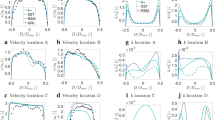Abstract
Aim of the project is the analysis of contrast agent dispersion in bolus-based quantitative myocardial perfusion MRI measurements. 3D-models are extracted from high-resolution cardiovascular cryomicrotome imaging data and subsequently meshed with computational grids. Computational fluid dynamics simulations are performed to solve Navier-Stokes equations for blood flow and the advection-diffusion equation for contrast agent transport to obtain bolus dispersion in epicardial vessels, i.e. bolus duration is increased which results in a systematic underestimation of myocardial blood flow. The dispersion of the injected bolus is observed at different positions along the passage through the cardiovascular vessel geometry and is quantified by means of the variance and transit times of the vascular transport function. We find multi-faceted influences on bolus shape from length of traversed vessels to bifurcation angles and vessel curvature. Therefore, depending on the exact anatomical region systematic errors of blood flow measurements are prone to spatial variance.
Access this chapter
Tax calculation will be finalised at checkout
Purchases are for personal use only
Similar content being viewed by others
Notes
- 1.
- 2.
- 3.
cfmesh.com, open source meshing library for OpenFOAM.
- 4.
Proprietary meshing software package usable in OpenFOAM.
- 5.
- 6.
https://github.com/Atizar/RapidCFD-dev, OpenFOAM fork for execution on GPU.
References
Graafen, D., Münnemann, K., Weber, S., Kreitner, K.-F., Schreiber, L.M.: Quantitative contrast-enhanced myocardial perfusion magnetic resonance imaging: Simulation of bolus dispersion in constricted vessels. Med. Phys. 36(7), 3099–3106 (2009)
Sommer, K., Bernat, D., Schmidt, R., Breit, H.-C., Schreiber, L.M.: Contrast agent bolus dispersion in a realistic coronary artery geometry: Influence of outlet boundary conditions. Ann. Biomed. Eng. 42(4), 787–796 (2013)
Sommer, K., Schmidt, R., Graafen, D., Breit, H.-C., Schreiber, L.M.: Resting myocardial blood flow quantification using contrast-enhanced magnetic resonance imaging in the presence of stenosis: A computational fluid dynamics study. Med. Phys. 42(7), 4375–4384 (2015)
Calamante, F., Yim, P.J., Cebral, J.R.: Estimation of bolus dispersion effects in perfusion MRI using image-based computational fluid dynamics. NeuroImage 19, 341–353 (2003)
Calamante, F., Willats, L., Gadian, D.G., Connelly, A.: Bolus delay and dispersion in perfusion MRI: Implications for tissue predictor models in stroke. Magn. Reson. Med. 55, 1180–1185 (2006)
van den Wijngaard, J.P.H.M., Schwarz, J.C.V., van Horssen, P., van Lier, M.G.J.T.B., Dobbe, J.G.G., Spaan, J.A.E., Siebes, M.: 3D Imaging of vascular networks for biophysical modeling of perfusion distribution within the heart. Biomech 46, 229–239 (2012)
Spaan, J.A.E., ter Wee, R., van Teeffelen, J.W.G.E., Streekstra, G., Siebes, M., Kolyva, C., Vink, H., Fokkema, D.S., VanBavel, E.: Visualisation of intramural coronary vasculature by an imaging cryomicrotome suggests compartmentalization of myocardial perfusion areas. Med. Biol. Eng. Comput. 43, 431–435 (2005)
De Santis, G., Mortier, P., De Beule, M., Segers, P., Verdonck, P., Verhegghe, B.: Patient-specific computational fluid dynamics: Structured mesh generation from coronary angiography. Med. Biol. Eng. Comput. 48, 371–380 (2010)
Schmidt, R., Graafen, D., Weber, S., Schreiber, L.M.: Computational fluid dynamics simulations of contrast agent bolus dispersion in a coronary bifurcation: Impact on MRI-based quantification of myocardial perfusion. Comput. Math. Methods Med. 2013 (2013)
Endspurt - die Skripten fürs Physikum - Physiologie 1, Georg Thieme Verlag KG (2011)
Olufsen, M.S., Peskin, C.S., Kim, W.Y., Pedersen, E.M., Nadim, A., Larsen, J.: Numerical simulation and experimental validation of blood flow in arteries with structured-tree outflow conditions. Ann. Biomed. Eng. 28, 1281–1299 (2000)
Cousins, W., Gremaud, P.A.: Boundary conditions for hemodynamics: The structured tree revisited. Comput. Phys. 231, 6086–6096 (2012)
Adam, J.A.: Blood vessel branching: Beyond the standard calculus problem. Math. Mag. 84, 196–207 (2011)
Graafen, D., Hamer, J., Weber, S., Schreiber, L.M.: Quantitative myocardial perfusion magnetic resonance imaging: The impact of pulsatile flow on contrast agent bolus dispersion. Phys. Med. Biol. 56, 5167–5185 (2011)
Mischi, M., den Boer, J.A., Korsten, H.H.M.: On the physical and stochastic representation of an indicator dilution curve as a gamma fit. Physiol. Meas. 29, 281–294 (2008)
Wieseotte, C., Wagner, M., Schreiber, L.M.: An estimate of Gd-DOTA diffusivity in blood by direct NMR diffusion measurement of its hydrodynamic analogue Ga-DOTA. In: Conference Paper, ISMRM Annual Meeting (2014)
Ewing, R.J., Bonekamp, D., Barker, P.B.: Clinical Perfusion MRI - Techniques and Applications. Cambridge University Press, Cambridge (2013)
Graafen, D.: Diploma Thesis. Johannes Gutenberg University Mainz, Untersuchung der Blutströmung in Herzkranzarterien mittels Computational Fluid Dynamics (2008)
King, R.B., Deussen, A., Raymond, G.M., Bassingthwaighte, J.B.: A vascular transport operator. Am. J. Physiol. 265, H2196–H2208 (1993)
Acknowledgments
We acknowledge financial support of German Ministry of Education and Research (BMBF, grants: 01EO1004, 01E1O1504). We acknowledge University Kaiserslautern for access to HPC-cluster elwetritsch. Special thanks to Dr. Karsten Sommer and Regine Schmidt (University Mainz).
Author information
Authors and Affiliations
Corresponding author
Editor information
Editors and Affiliations
Rights and permissions
Copyright information
© 2017 Springer International Publishing AG
About this paper
Cite this paper
Martens, J., Panzer, S., van den Wijngaard, J.P.H.M., Siebes, M., Schreiber, L.M. (2017). Analysis of Coronary Contrast Agent Transport in Bolus-Based Quantitative Myocardial Perfusion MRI Measurements with Computational Fluid Dynamics Simulations. In: Pop, M., Wright, G. (eds) Functional Imaging and Modelling of the Heart. FIMH 2017. Lecture Notes in Computer Science(), vol 10263. Springer, Cham. https://doi.org/10.1007/978-3-319-59448-4_35
Download citation
DOI: https://doi.org/10.1007/978-3-319-59448-4_35
Published:
Publisher Name: Springer, Cham
Print ISBN: 978-3-319-59447-7
Online ISBN: 978-3-319-59448-4
eBook Packages: Computer ScienceComputer Science (R0)




